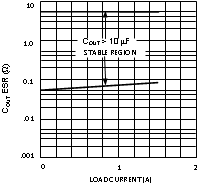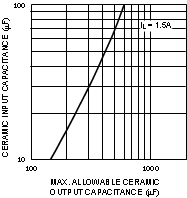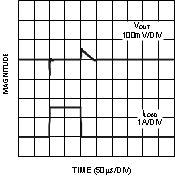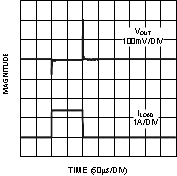SNVS174I February 2003 – February 2015 LP3852 , LP3855
PRODUCTION DATA.
- 1 Features
- 2 Applications
- 3 Description
- 4 Simplified Schematics
- 5 Revision History
- 6 Voltage Options
- 7 Pin Configuration and Functions
- 8 Specifications
- 9 Detailed Description
-
10Application and Implementation
- 10.1 Application Information
- 10.2
Typical Applications
- 10.2.1 Design Requirements
- 10.2.2 Detailed Design Procedure
- 10.2.3 Application Curves
- 11Power Supply Recommendations
- 12Layout
- 13Device and Documentation Support
- 14Mechanical, Packaging, and Orderable Information
10 Application and Implementation
NOTE
Information in the following applications sections is not part of the TI component specification, and TI does not warrant its accuracy or completeness. TI’s customers are responsible for determining suitability of components for their purposes. Customers should validate and test their design implementation to confirm system functionality.
10.1 Application Information
The LP3852 and LP3855 devices can provide 1.5-A output current with 2.5-V to 7-V input. A minimum 10-uF output capacitor is required for loop stability. An input capacitor of at least 10 µF is required . Pin SD must be tied to input if not used. For LP3852, ERROR pin should be pulled high through a pullup resistor. For LP3855, if the sense option is not required , the SENSE pin must be connected to the OUT pin.
10.2 Typical Applications
 Figure 18. LP3852 Typical Application
Figure 18. LP3852 Typical Application
 Figure 19. LP3855 Typical Application
Figure 19. LP3855 Typical Application
10.2.1 Design Requirements
| DESIGN PARAMETERS | VALUE |
|---|---|
| Input voltage | 3.3 V, ±10% |
| Output voltage | 2.5 V, ±3% |
| Output current | 1.5 A (maximum) |
| Input capacitor | 10 µF (minimum) |
| Output capacitor | 10 µF (minimum) |
| ERROR pullup resistor (LP3852 only) | 10 kΩ |
10.2.2 Detailed Design Procedure
10.2.2.1 External Capacitors
Like any low dropout regulator, external capacitors are required to assure stability. These capacitors must be correctly selected for proper performance.
10.2.2.1.1 Input Capacitor
An input capacitor of at least 10 µF is required. Ceramic or tantalum may be used, and capacitance may be increased without limit.
10.2.2.1.2 Output Capacitor
An output capacitor is required for loop stability. It must be located less than 1 cm from the device and connected directly to the output and ground pins using traces which have no other currents flowing through them (see Layout Guidelines).
The minimum amount of output capacitance that can be used for stable operation is 10 µF. For general usage across all load currents and operating conditions, the part was characterized using a 10-µF tantalum input capacitor. The minimum and maximum stable equivalent series resistance (ESR) range for the output capacitor was then measured which kept the device stable, assuming any output capacitor whose value is greater than 10 µF (see Figure 20).
 Figure 20. ESR Curve For COUT (with 10-µF Tantalum Input Capacitor)
Figure 20. ESR Curve For COUT (with 10-µF Tantalum Input Capacitor)
It should be noted that it is possible to operate the part with an output capacitor whose ESR is below these limits, assuming that sufficient ceramic input capacitance is provided. This will allow stable operation using ceramic output capacitors (see Operation with Ceramic Output Capacitors).
10.2.2.2 Operation with Ceramic Output Capacitors
LP385X voltage regulators can operate with ceramic output capacitors if the values of the input and output capacitors are selected appropriately. The total ceramic output capacitance must be equal to or less than a specified maximum value in order for the regulator to remain stable over all operating conditions. This maximum amount of ceramic output capacitance is dependent upon the amount of ceramic input capacitance used as well as the load current of the application. This relationship is shown in Figure 21, which graphs the maximum stable value of ceramic output capacitance as a function of ceramic input capacitance for load currents of 1.5 A.
 Figure 21. Maximum Ceramic Output Capacitance vs Ceramic Input Capacitance
Figure 21. Maximum Ceramic Output Capacitance vs Ceramic Input Capacitance
If the maximum load current is 1.5 A and a 10-µF ceramic input capacitor is used, the regulator will be stable with ceramic output capacitor values from 10 µF up to about 150 µF. When calculating the total ceramic output capacitance present in an application, it is necessary to include any ceramic bypass capacitors connected to the regulator output.
10.2.2.3 Selecting A Capacitor
It is important to note that capacitance tolerance and variation with temperature must be taken into consideration when selecting a capacitor so that the minimum required amount of capacitance is provided over the full operating temperature range. In general, a good tantalum capacitor will show very little capacitance variation with temperature, but a ceramic may not be as good (depending on dielectric type). Aluminum electrolytics also typically have large temperature variation of capacitance value.
Equally important to consider is a capacitor's ESR change with temperature: this is not an issue with ceramics, as their ESR is extremely low. However, it is very important in Tantalum and aluminum electrolytic capacitors. Both show increasing ESR at colder temperatures, but the increase in aluminum electrolytic capacitors is so severe they may not be feasible for some applications (see Capacitor Characteristics).
10.2.2.4 Capacitor Characteristics
10.2.2.4.1 Ceramic
For values of capacitance in the 10-µF to 100-µF range, ceramics are usually larger and more costly than tantalums but give superior AC performance for bypassing high frequency noise because of very low ESR (typically less than 10 mΩ). However, some dielectric types do not have good capacitance characteristics as a function of voltage and temperature.
Z5U and Y5V dielectric ceramics have capacitance that drops severely with applied voltage. A typical Z5U or Y5V capacitor can lose 60% of its rated capacitance with half of the rated voltage applied to it. The Z5U and Y5V also exhibit a severe temperature effect, losing more than 50% of nominal capacitance at high and low limits of the temperature range.
X7R and X5R dielectric ceramic capacitors are strongly recommended if ceramics are used, as they typically maintain a capacitance range within ±20% of nominal over full operating ratings of temperature and voltage. Of course, they are typically larger and more costly than Z5U/Y5U types for a given voltage and capacitance.
10.2.2.4.2 Tantalum
Solid tantalum capacitors are typically recommended for use on the output because their ESR is very close to the ideal value required for loop compensation.
Tantalum capacitors also have good temperature stability: a good quality tantalum capacitor will typically show a capacitance value that varies less than 10-15% across the full temperature range of 125°C to −40°C. ESR will vary only about 2X going from the high to low temperature limits.
The increasing ESR at lower temperatures can cause oscillations when marginal quality capacitors are used (if the ESR of the capacitor is near the upper limit of the stability range at room temperature).
10.2.2.4.3 Aluminum
This capacitor type offers the most capacitance for the money. The disadvantages are that they are larger in physical size, not widely available in surface mount, and have poor AC performance (especially at higher frequencies) due to higher ESR and ESL.
Compared by size, the ESR of an aluminum electrolytic is higher than either tantalum or ceramic, and it also varies greatly with temperature. A typical aluminum electrolytic can exhibit an ESR increase of as much as 50X when going from 25°C down to −40°C.
It should also be noted that many aluminum electrolytics only specify impedance at a frequency of 120 Hz, which indicates they have poor high frequency performance. Only aluminum electrolytics that have an impedance specified at a higher frequency (between 20 kHz and 100 kHz) should be used for the LP385X. Derating must be applied to the manufacturer's ESR specification, since it is typically only valid at room temperature.
Any applications using aluminum electrolytics should be thoroughly tested at the lowest ambient operating temperature where ESR is maximum.
10.2.2.5 Turnon Characteristics For Output Voltages Programmed to 2 V or Below
As VIN increases during start-up, the regulator output will track the input until VIN reaches the minimum operating voltage (typically about 2.2 V). For output voltages programmed to 2 V or below, the regulator output may momentarily exceed its programmed output voltage during start up. Outputs programmed to voltages above 2 V are not affected by this behavior.
10.2.2.6 Output Noise
Noise is specified in two ways:
- Spot Noise or Output Noise Density is the RMS sum of all noise sources, measured at the regulator output, at a specific frequency (measured with a 1-Hz bandwidth). This type of noise is usually plotted on a curve as a function of frequency.
- Total Output Noise or Broad-Band Noise is the RMS sum of spot noise over a specified bandwidth, usually several decades of frequencies.
Attention should be paid to the units of measurement. Spot noise is measured in units µV/√Hz or nV/√Hz, and total output noise is measured in µVRMS.
The primary source of noise in low-dropout regulators is the internal reference. In CMOS regulators, noise has a low frequency component and a high frequency component, which depend strongly on the silicon area and quiescent current. Noise can be reduced in two ways: by increasing the transistor area or by increasing the current drawn by the internal reference. Increasing the area will decrease the chance of fitting the die into a smaller package. Increasing the current drawn by the internal reference increases the total supply current (ground pin current). Using an optimized trade-off of ground pin current and die size, LP3852 and LP3855 achieve low noise performance and low quiescent-current operation.
The total output noise specification for LP3852 and LP3855 is presented in the Electrical Characteristics table. The Output noise density at different frequencies is represented by a curve under Typical Characteristics.
10.2.3 Application Curves

| CIN = COUT = 10 µF, OSCON | ||

| CIN = COUT = 10 µF, Tantalum | ||